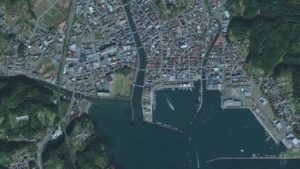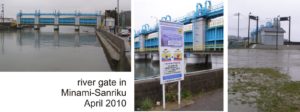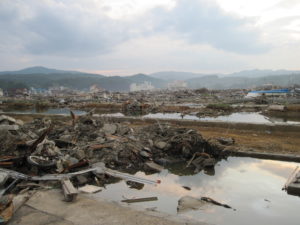I thought I knew what the aftermath ugly would look like, but as I’ve been researching for a presentation on ground truth of a Cascadia, ugly is going to a whole new level. Part of a presentation I’m preparing to give this summer involves a comparison of two cities. Minamisanriku, Japan and Seaside, Oregon.

Minamisanriku for better or worse has more experience with tsunamis than Seaside. Prior to the 2011 event they had two local tsunamis, one in 1896 and one in 1933. Neither of those were greater than 3.5 meters in height. In 1960 a subduction zone earthquake off of Chile sent a 5 meter tsunami through the community, destroying it and leaving dead in it’s wake.
 As a result of the 1960 tsunami, river-gates were installed which could be remotely closed in the event of a tsunami. Water will always take the easiest route and will flow up rivers, channels and bays. The gates function to let the river flow out normally but could be closed to prevent massive flooding. Another Chile earthquake in 2010 sent another tsunami towards Minamisanriku. This time the river gates were closed, people evacuated to high ground and although there was damage to the community, there were no fatalities.
As a result of the 1960 tsunami, river-gates were installed which could be remotely closed in the event of a tsunami. Water will always take the easiest route and will flow up rivers, channels and bays. The gates function to let the river flow out normally but could be closed to prevent massive flooding. Another Chile earthquake in 2010 sent another tsunami towards Minamisanriku. This time the river gates were closed, people evacuated to high ground and although there was damage to the community, there were no fatalities.
Thirty minutes after the earthquake in 2011, the tsunami arrived and Minamisanriku was for all practical purposes destroyed. Initially half of the 17,000 residents were missing or dead.  Their two evacuation centers sitting at 20 meter elevation were inundated and people washed away. Almost half of the 80 designated evacuation sites were inundated by the tsunami. A hospital several kilometers inland, and anticipated to be safe, saw water coming into the facility. Staff stayed and desperately tried to carry patients on their backs to the third floor. It wasn’t high enough. Only 30 of 110 patients survived.
Their two evacuation centers sitting at 20 meter elevation were inundated and people washed away. Almost half of the 80 designated evacuation sites were inundated by the tsunami. A hospital several kilometers inland, and anticipated to be safe, saw water coming into the facility. Staff stayed and desperately tried to carry patients on their backs to the third floor. It wasn’t high enough. Only 30 of 110 patients survived.
I went looking for answers on how such a seemingly experienced and well prepared community could be so devastated. It turns out I violated my own advice I have given to others over the years. Never ask a question that you don’t really want to know the answer to. It turns out the 2011 tsunami baffled the world’s experts as it was far bigger than might have been anticipated. What scientists found was the squeezing together of two plates in the earth’s crust not only resulted in a fracture but also caused a massive collapse of the debris that had built up on the sea bed as tectonic movements scraped loose sediment into an unstable wedge.
When the wedge of material collapsed, the leading edge split off and shot forward. In essence, what happened was a release of both the elastic energy stored in the rocks and the gravitational energy contained in the wedge-shaped build-up of debris. The extra movement of the sea bed at the toe of the wedge enhanced the shape of the huge wave created at the surface of the sea, which traveled towards Minamisanriku, about 70 kilometers away.
Here’s where my Cascadia nightmare gets worse. Our current tsunami inundation zone maps for the west coast are based on the best scientific estimates. But what if. What if a similar condition of built up debris is associated with the fault movement. I even have to wonder if dredge spoils dumped off the coast might not come into play as well. I understand for planning purposes you have to draw a line somewhere. What I’m suggesting is that local planners and facility emergency management personnel may be wise to hedge their bets. Don’t count on our current estimates as being fact. Keep in mind Minamisanriku had taken numerous more steps as ensuring the safety of their community then we here in the United States have even discussed.
I hope I’m wrong about this. On the other hand if I were responsible for the safety of others along the west coast, I’d be bringing my planning team back to the table. I’d love to hear your thoughts on this topic. Would you try and be even more conservative, just in case.



Hello Jan,
Another great article based on some solid research. I agree we have to draw a line, especially in exercises as we will never be able to simulate the worst and some preparation is better than none if we accidentally discourage participants. But this made me think about a recent discussion with a Deputy Ops Chief during my latest Threat Hazard and Risk Assessment as part of an EOP rewrite.
When I did the math on local train derailments and hazmat releases the probability (likelihood) and criticality (impact) calculated out to a “moderate” risk. With some knowledge of hazmat, I spread my research to regional: still moderate. Even looking at the national numbers with the number of trains on the rails compared to the number of incidents, and liited number of severe incidents, it came out to between low and moderate.
Then the Chief said, based on a recent WV release (over 8,000 evacuated) and the Greenville, SC chlorine release some years ago, we must have a way to incorporate the catastrophic severity even if unlikely to ensure it is recognized. Initially he wanted to just bump it up to high. First, I used a 1-10 index based on number of identified threats to allow for actual prioritization verses the High, Medium, Low model typically used. Then applied high, med and low over the numbers once ranked. This allows for budgeting and real planning over time.
I crunched numbers looking at the various threats and hazards and came up with a 1.75 factor for those that have shown catastrophic impacts on a low probability scale. This bumped the HazMat derailment up to a moderate High and made everyone happy, while still showing the science verses the typical “I think this is the worst or most likely” approach. I didn’t have the time needed to conduct a fully effective TRA but I believe it lent itself to more realistic results with some scientific backing.
In my experience, especially with the invent of the THIRA, most jurisdictions don’t do a great job on the Threat and Risk portion of assessments.
Apologies for getting off track a bit but I felt it applied to what you were discussing.
Dusty
I agree with your conclusions there Dusty. A jurisdictions appetite for risk is also an intangible factor. You or I may be concerned about an event based upon following a process but local policy-makers may determine(unscientifically but based on factors important to them) that they are willing to take the risk and not address the issue. It’s always a headache and liability for the boss when you point out a problem and they chose to ignore it.
Hi , in the ground it’s hard to do a big change to reduce the danger of the tsunamis, so it’s good to fight the enemy’s ( tsunamis) in their land . What I mean is to find a way off reducing the power and the dangerous of the tsunamis before they get to the land . In my opinion to creating a man made power action against the tsunami power reduced the risk and the loss . I know some people will say are you crazy to say that, but the fact show the humans can do miracles if think the right way.
Hi Jan
I’m a Disaster Manager in Perth, Western Australia.
My colleague and I have been working on a research topic specifically making an assessment of inundation profiles based on a (perceived) worst-case scenario involving a sub-sea tsunamigenic earthquake event in the Sunda Arc, South-West of the Indonesian Archipelago.The focus of our research is to develop a reproducible inundation assessment method and to identify inundation impacts to Health infrastructure such as hospitals, health centres etc throughout Western Australia.
This research is extremely valuable for Western Australia as there is demonstrable evidence of at least two tsunami inundations in the North-West of the state over the last thousand years with inundation heights reaching 20-30 metres in height.
To this time, there has been no application of tsunami modelling to Health infrastructure throughout this state – this really flags this as an unidentified risk that is yet to be fully assessed.
In our review of the available modelling data to this point, one of our major concerns is that the latest data is old – from around 2004-2007 and is based on poor quality bathymetry data. Using outdated data to make our assessment can only ever be recognised as a “best assessment” as it is potentially unreliable.
Your article has added another layer of uncertainty around our assessment – specifically the inclusion of “stacking” events subsequent to an original tsunamigenic event, that we could look to include or comment to…
Thanks for the prompt.
Rob
At what point does uncertainty increase risk of consequences Rob? Earthquakes are notoriously difficult to predict. We know factors such as debris stacking can increase wave height. Do we error on the side of caution now or wait until we have data to confirm or rule out?
Having lived in Oregon most of my life and Seaside as my Backyard, you are correct is we really Don’t know the effects of a major tsunamis on the Oregon cost. We have only (the Whiteman) lived here for 150 ish years. Time has not taught us our lesson as yet. Take all that you have said and add landslides the we are fighting on a normal wet day. Add Liquefaction, the 3-5 miles inland of coast are build-up of wet sands. Finally add Seashelf Drop, where the coastline drops from the pressure released after the quake, in some places this can be 20′. Add that to your inundation zone ( and how could you predict that …).
Being from Oregon and living there as you Bill I know exactly what you’re talking about with collateral impacts. Landslides in Portland and Astoria happen every year. I recall one year when Ecola State Park was closed not just do to the road sliding but an entire hill swept through the parking lot. If a Cascadia were to occur during a winter-storm, high tide with a strong storm surge….ugly.
Well bummer. Looks like this very well could be in play.
https://www.eurekalert.org/pub_releases/2017-05/osu-sfh052517.php